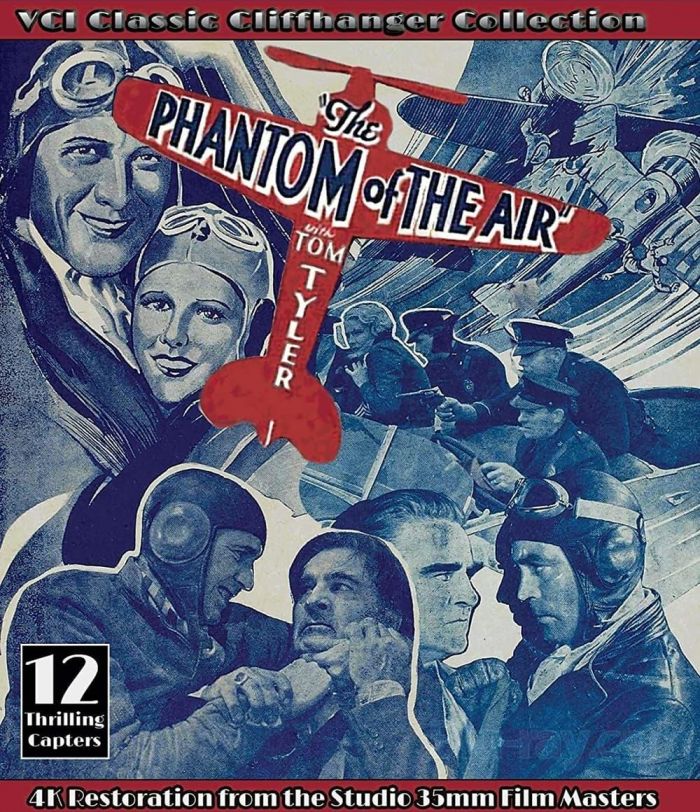The Phantom of the Air by Ray Taylor (Review)

As I write this review, the nation’s top movie is Top Gun: Maverick, which has wowed audiences with thrilling aerial sequences that were performed by Tom Cruise and the rest of the cast without the usual help of visual effects. However, Hollywood has a long, rich history of aerial stunts, as evidenced by The Phantom of the Air, a 12-episode pre-Code serial that originally ran in 1933, and was remastered and restored in 4K last year.
Captain Bob Raymond (Tom Tyler) is a skilled pilot and dedicated member of the Border Patrol, where he fearlessly guards America’s skies from smugglers. That makes him just the sort of man that Thomas Edmonds (William Desmond) needs to protect his latest invention: an anti-gravity device that would spell doom for the world were it to fall into the wrong hands. Intrigued by the job — and Edmonds’ headstrong and beautiful daughter, Mary (Gloria Shea) — Raymond takes the gig, which soon lands him in the crosshairs of a deadly smuggler gang led by sneaky industrialist Mortimer Crome (LeRoy Mason), who has managed to worm his way into the Edmonds’ good graces.
Given that The Phantom of the Air is a classic Hollywood serial, you should know what to expect: ridiculous cliffhangers designed to get crowds back into the theater each week for the equally ridiculous escape; damsels in distress; and our stalwart hero slugging it out with Crome and his cronies. However, The Phantom of the Air also has the benefit of some truly stunning aerial sequences, be it the thrilling race in the first episode or the various dogfights between Raymond and Crome’s gang, in which biplanes are seen spinning and twirling amongst the clouds.
While some of the stunts were obviously performed on a Hollywood soundstage, many were done for real, and they easily stand up to anything Tom Cruise might attempt in his movies. Be it pilots walking across the wings of one aircraft in flight to another, folks diving to the ground as a plane comes within inches of their heads, or piloted planes crashing for real, I wouldn’t be at all surprised if Cruise watched The Phantom of the Air (or similar titles) for some inspiration.
Unfortunately, the same things that make these movie serials so charming can also be their downfall. Logic and consistency aren’t the focus here, which explains why everyone’s revolvers hold approximately a hundred bullets, how Raymond is able to shrug off gunshot wounds and walk away from plane crashes, and why airplanes change size, shape, and color from one shot to the next. And somehow, the bad guys keep finding Edmonds’ secret desert airstrip with ease, while Edmonds has a seemingly infinite supply of airplanes in the hangar.
As for the anti-gravity device itself, Edmonds’ so-called ContraGrav, best not to think too hard about how it works (this isn’t a sci-fi serial, after all), or why Raymond was actually needed in the first place. Or, given how often Crome’s gang endangers the lives of Edmonds and his daughter, that their faith in Raymond might’ve been a little misplaced. (Don’t worry though. Nobody’s life is ever really in danger unless they’re a smuggler, in which case, they’ll realize the error of their ways when they land on death’s door.)
I suppose you could just say it was a simpler time back then, and audiences weren’t so demanding of their entertainment (and said entertainment was probably made on a budget that made “shoestring” seem generous by comparison). Be that as it may, that certainly didn’t keep The Phantom of the Air’s various stunt flyers — all of whom were, sadly, uncredited — from giving it their all and risking life and limb to create dazzling displays of aerial derring do for the audience’s enjoyment.
The Phantom of the Air is currently streaming for free on Tubi.